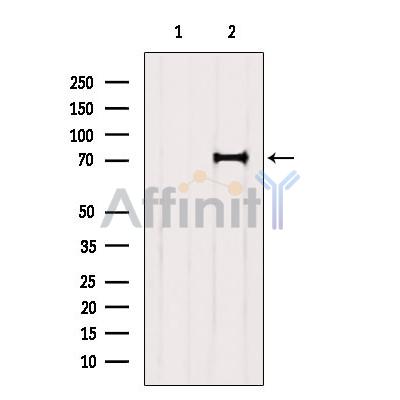BBS7 Antibody - #DF12249
| Product: | BBS7 Antibody |
| Catalog: | DF12249 |
| Description: | Rabbit polyclonal antibody to BBS7 |
| Application: | WB IHC IF/ICC |
| Reactivity: | Human, Mouse, Rat |
| Prediction: | Pig, Zebrafish, Bovine, Horse, Sheep, Rabbit, Dog, Chicken, Xenopus |
| Mol.Wt.: | 75 kDa; 80kD(Calculated). |
| Uniprot: | Q8IWZ6 |
| RRID: | AB_2845054 |
Related Downloads
Protocols
Product Info
*The optimal dilutions should be determined by the end user. For optimal experimental results, antibody reuse is not recommended.
*Tips:
WB: For western blot detection of denatured protein samples. IHC: For immunohistochemical detection of paraffin sections (IHC-p) or frozen sections (IHC-f) of tissue samples. IF/ICC: For immunofluorescence detection of cell samples. ELISA(peptide): For ELISA detection of antigenic peptide.
Cite Format: Affinity Biosciences Cat# DF12249, RRID:AB_2845054.
Fold/Unfold
Bardet Biedl syndrome 7 protein; Bardet-Biedl syndrome 7; Bardet-Biedl syndrome 7 protein; BBS2 like 1; BBS2 like protein 1; BBS2-like protein 1; BBS2L1; BBS7; BBS7_HUMAN; FLJ10715;
Immunogens
A synthesized peptide derived from human BBS7, corresponding to a region within the internal amino acids.
Isoform 2 is ubiquitously expressed. Isoform 1 is expressed in retina, lung, liver, testis, ovary, prostate, small intestine, liver, brain, heart and pancreas.
- Q8IWZ6 BBS7_HUMAN:
- Protein BLAST With
- NCBI/
- ExPASy/
- Uniprot
MDLILNRMDYLQVGVTSQKTMKLIPASRHRATQKVVIGDHDGVVMCFGMKKGEAAAVFKTLPGPKIARLELGGVINTPQEKIFIAAASEIRGFTKRGKQFLSFETNLTESIKAMHISGSDLFLSASYIYNHYCDCKDQHYYLSGDKINDVICLPVERLSRITPVLACQDRVLRVLQGSDVMYAVEVPGPPTVLALHNGNGGDSGEDLLFGTSDGKLALIQITTSKPVRKWEIQNEKKRGGILCIDSFDIVGDGVKDLLVGRDDGMVEVYSFDNANEPVLRFDQMLSESVTSIQGGCVGKDSYDEIVVSTYSGWVTGLTTEPIHKESGPGEELKINQEMQNKISSLRNELEHLQYKVLQERENYQQSSQSSKAKSAVPSFGINDKFTLNKDDASYSLILEVQTAIDNVLIQSDVPIDLLDVDKNSAVVSFSSCDSESNDNFLLATYRCQADTTRLELKIRSIEGQYGTLQAYVTPRIQPKTCQVRQYHIKPLSLHQRTHFIDHDRPMNTLTLTGQFSFAEVHSWVVFCLPEVPEKPPAGECVTFYFQNTFLDTQLESTYRKGEGVFKSDNISTISILKDVLSKEATKRKINLNISYEINEVSVKHTLKLIHPKLEYQLLLAKKVQLIDALKELQIHEGNTNFLIPEYHCILEEADHLQEEYKKQPAHLERLYGMITDLFIDKFKFKGTNVKTKVPLLLEILDSYDQNALISFFDAA
Predictions
Score>80(red) has high confidence and is suggested to be used for WB detection. *The prediction model is mainly based on the alignment of immunogen sequences, the results are for reference only, not as the basis of quality assurance.
High(score>80) Medium(80>score>50) Low(score<50) No confidence
Research Backgrounds
The BBSome complex is thought to function as a coat complex required for sorting of specific membrane proteins to the primary cilia. The BBSome complex is required for ciliogenesis but is dispensable for centriolar satellite function. This ciliogenic function is mediated in part by the Rab8 GDP/GTP exchange factor, which localizes to the basal body and contacts the BBSome. Rab8(GTP) enters the primary cilium and promotes extension of the ciliary membrane. Firstly the BBSome associates with the ciliary membrane and binds to RAB3IP/Rabin8, the guanosyl exchange factor (GEF) for Rab8 and then the Rab8-GTP localizes to the cilium and promotes docking and fusion of carrier vesicles to the base of the ciliary membrane. The BBSome complex, together with the LTZL1, controls SMO ciliary trafficking and contributes to the sonic hedgehog (SHH) pathway regulation. Required for proper BBSome complex assembly and its ciliary localization.
Cell projection>Cilium membrane. Cytoplasm. Cytoplasm>Cytoskeleton>Microtubule organizing center>Centrosome>Centriolar satellite. Cytoplasm>Cytoskeleton>Cilium basal body.
Isoform 2 is ubiquitously expressed. Isoform 1 is expressed in retina, lung, liver, testis, ovary, prostate, small intestine, liver, brain, heart and pancreas.
Restrictive clause
Affinity Biosciences tests all products strictly. Citations are provided as a resource for additional applications that have not been validated by Affinity Biosciences. Please choose the appropriate format for each application and consult Materials and Methods sections for additional details about the use of any product in these publications.
For Research Use Only.
Not for use in diagnostic or therapeutic procedures. Not for resale. Not for distribution without written consent. Affinity Biosciences will not be held responsible for patent infringement or other violations that may occur with the use of our products. Affinity Biosciences, Affinity Biosciences Logo and all other trademarks are the property of Affinity Biosciences LTD.

